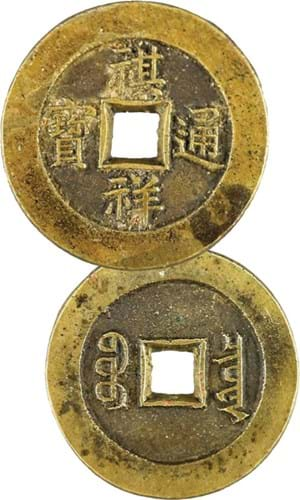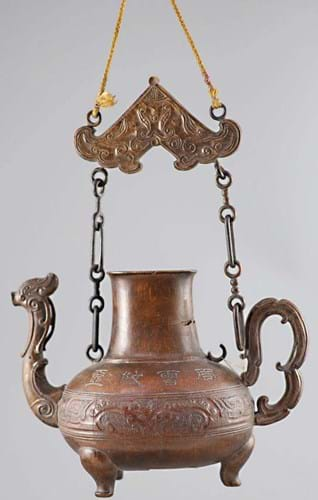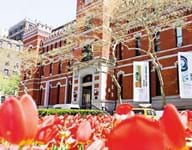Nearly a quarter of the 590 lots came from the family of the published antiquarian and Far Eastern scholar Alfred Theodore Arber-Cooke (c.1905-93).
Sixteen lots of carved bamboo came from the expat Dr John William Hawksley Grice (1891-1976) who worked in Tianjin from 1922-52.
Living first in Wimbledon and then in a village in Camarthen, Arber-Cooke was collecting from the 1940s to the 1980s.
His family’s inheritance included the day’s top-seller, the £190,000 Bartolomeo Cavaceppi marble after the Medici Apollo discussed in last week’s issue (News Digest, ATG No 2488).
Far East expertise
Arber-Cooke’s expertise, however, was better reflected in his many examples of Far East coinage, charms and amulets. About 2000 of them were offered in 95 lots and all got away at the March 30 sale, totalling £185,000 against a top estimate of £25,000.
“We did expect them to make more than the estimates but not to that extent,” said Dan Bray, the Gorringe’s specialist who combined his expertise in Asia and of coins generally when cataloguing the sale.
Multi-estimate bids on mixed lots largely accounted for the disparity but the top lot was a single item – a bronze Qi Xiang tong bao.
Also called ‘mother coins’, engraved tong baos were used to make sand moulds from which general coinage was produced. All are intrinsically rare but this example related to the five-year-old emperor Qixiang who reigned in 1871 for only 69 days under that name. His mother then staged a palace coup and changed her son-emperor’s name to Tongzhi.
Fewer Qixiang coins were cast than for any other Qing reign. However, Bray had deemed this 2.8cm diameter die a copy and accordingly guided it at just £100-150. “A reference book raised questions about its size,” he explained.
Bidders disagreed and the coin sold to Mainland China at £22,000.
“It was the genuine article and made its right price,” said Bray. “We later found that the reference book was misleading.”
Chinese bronze and brass amulets have been the subject of forgeries since the 1990s when they began to make good money. However, a book on the subject published in Holland in 1968 drew heavily on the Arber-Cooke Collection and illustrated the pieces on offer at Lewes.
Topping the multi-item lots, which constantly eclipsed three-figure estimates, was one which comprised a group of 99 Korean bronze and metal amulets or charms. Pitched at £300-500 the group sold online to a South Korean collector at £19,000.
Also keenly sought were a dozen lots of reference works from Arber-Cooke’s library including two works on coin collecting by the scholar Li Zhuoxian. His 16-volume Gu quan hui and four-volume Xua quan hui were in reasonable condition and, against a £200-300 estimate, sold at £6000 to the Chinese mainland.
Arber-Cooke’s love of the East extended to the traditional collecting areas of bronzes and porcelain.
Among his Chinese bronzes, a 10in (25cm) tall, late Ming figure of Shancai Tongzi, the ‘Child of Wealth’ in the Avatamsaka Sutra, stood out and sold at £7500, some 25 times the top estimate.
Best of his porcelain was a 21in (46cm) diameter late 19th century famille verte fish bowl. Painted with a battle scene to the exterior and goldfish to the interior, it was generally in good condition and went to a European online bidder for £8000 (estimate £2000-3000).
Among the furniture was a c.1910, 3ft 1in (93cm) square Chinese hardwood table screen carved and pierced with scrolling chi-dragons on a stand carved and pierced with squirrels amid flowers and leaves.
Pitched at £400-600, it went to another bidder from the Continent at £7000.
Rare carvings
Bamboo carving is rated one of the minor arts of China and a tier below carvings in other materials such as zitan, aloeswood, ivory or rhino horn.
There are relatively few major public or private collections, with most buyers traditionally focusing attention on Ming or early Qing pieces. The Charles Blumenfield collecton sold in 60 lots at Sotheby’s Hong Kong in 2015 was a good example.
Hawksley Grice’s enthusiasm for later Qing carvings seems to have been unique among his peers.
After his return to the UK he had donated most of his bamboo works to the V&A (and ivories to the British Museum) but these 16 pieces were those kept by the family. Some bore loan labels from later V&A exhibitions.
“It could be 10 years before we see another such collection come to market,” said Bray. Priced to sell, they nevertheless exceeded expectations at Gorringe’s.
Best was the 18th or 19th century ‘boys and fish bowl’ brush washer, carved in the round from a bamboo-root node, pictured top. The 2in (5cm) high carving of an auspicious subject had some small losses but pitched at £600-800 sold to Mainland China at £27,000.
An 8½in (22cm) tripod ritual vessel carved in low relief with a band of masks and applied with zoomorphic spout was dated to the 18th century. It had a nominal £300- 500 estimate and sold to a UK-based bidder at £25,000.
A Qianlong period (1736-95) bamboo veneer (tiehuang) shaped square box went to China at £9000. Measuring 8in (20cm) square, the cover with re-entrant corners was carved in relief with dragons amid scrolling tendrils and inlaid with turquoise flower heads.


















